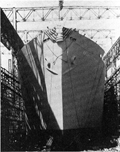E N I G M A
Saved by the Bell
Even though there isn't an ocean within at least two hundred miles of the University, Emory's presence has been felt on the high seas. During World War II, more than 3,500 alumni and former students served in the military, and 121 lost their lives. In 1945, to honor Emory's role during the war, a 10,700-ton cargo ship was christened the M.S. Emory Victory.
The ship was built by the Bethlehem-Fairfield Shipyard and launched in Baltimore. The actual christening was performed by Mrs. Warren H. Cox '35G, the daughter-in-law of Harvey W. Cox, who served as president of the University from 1920 to 1942. According to an article in the March 1945 issue of the Emory Alumnus, "When the time came for her to christen the ship her first swing failed to break the bottle. Her second and successful swing came just in the nick of time, as the ship had already started its journey down the greased ways."
The Emory Victory was designed as a postwar cargo vessel, but it was called to military service during the Korean War. According to the April 1952 issue of the Emory Alumnus, during that conflict it was used "to transport cargo for the Military Sea Transportation Service to ports all over the world."
In 1962, Emory's seafaring days came to an end. The Emory Victory was transferred to the Department of the Interior's Bureau of Indian Affairs in Seattle and renamed the North Star III. The ship was used to transport supplies to remote outposts in the Pacific Ocean, Bering Sea, and Arctic Ocean that were not served by commercial carriers. A letter from the Bureau of Indian Affairs sent to the University in 1964 stated that the supplies were "used by Native people, teachers, missionaries, doctors, and private traders in these small Aleut, Indian, and Eskimo villages."
William Allard, a spokesperson for the Bureau of Indian Affairs, says the ship was used until 1984, when it was decommissioned. It sat outside the Bremerton Naval Yard near Seattle until 1991, when it was sold for scrap and towed to the Far East to be melted down.
Emory was, however, presented with a memento from the Emory Victory. Through the efforts of Guy W. Trump, then dean of the business school, the bell from the ship was sent to the University in 1964. For years, the large brass bell stood in the entranceway on the second floor of the Administration Building. When the building recently underwent renovation, however, the bell was sent to the Materiel Center for safekeeping. A University spokesperson says the bell will be kept in storage until an appropriate place to display it becomes available.--J.D.T.
Return to Summer 1997 contents page.
